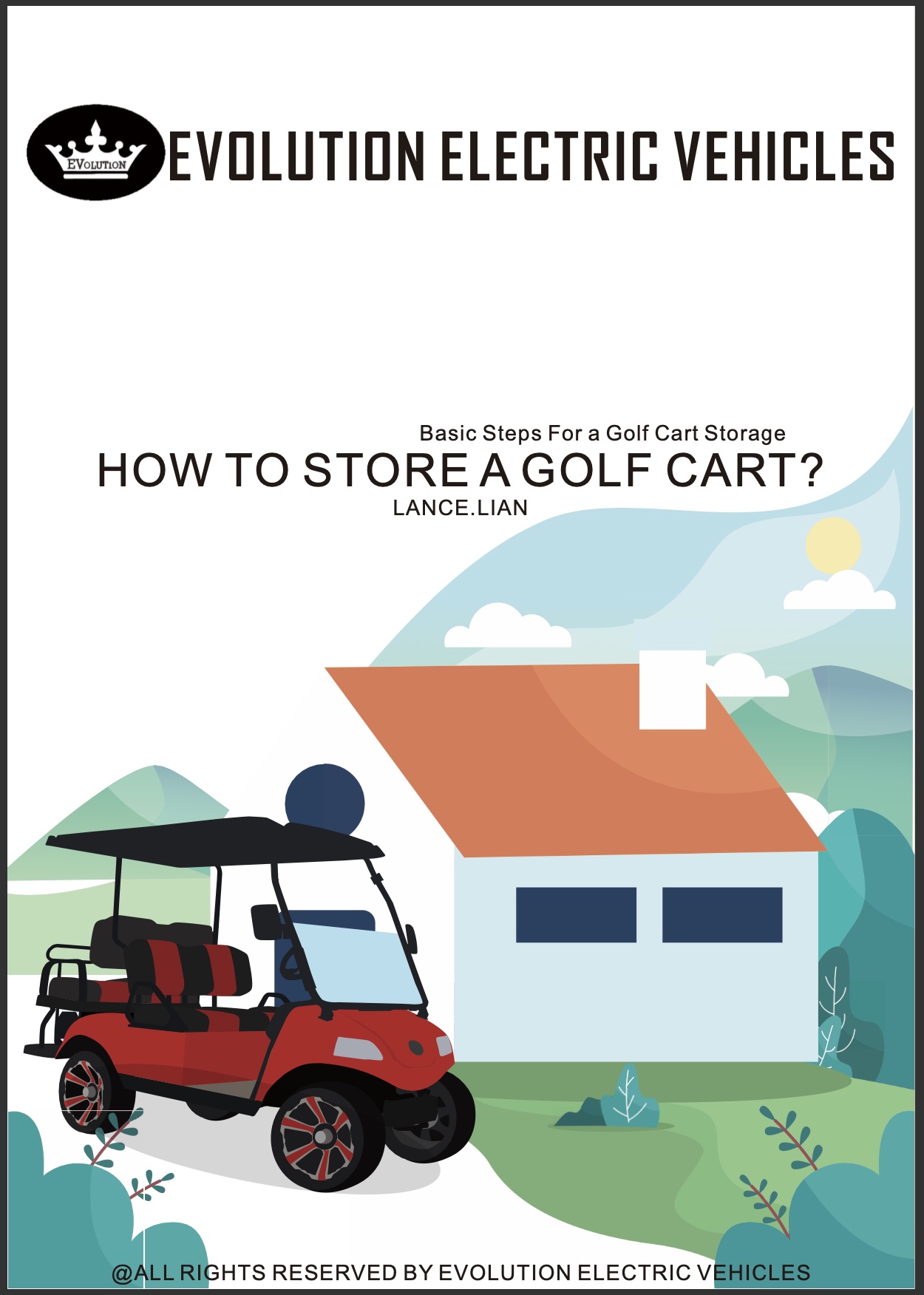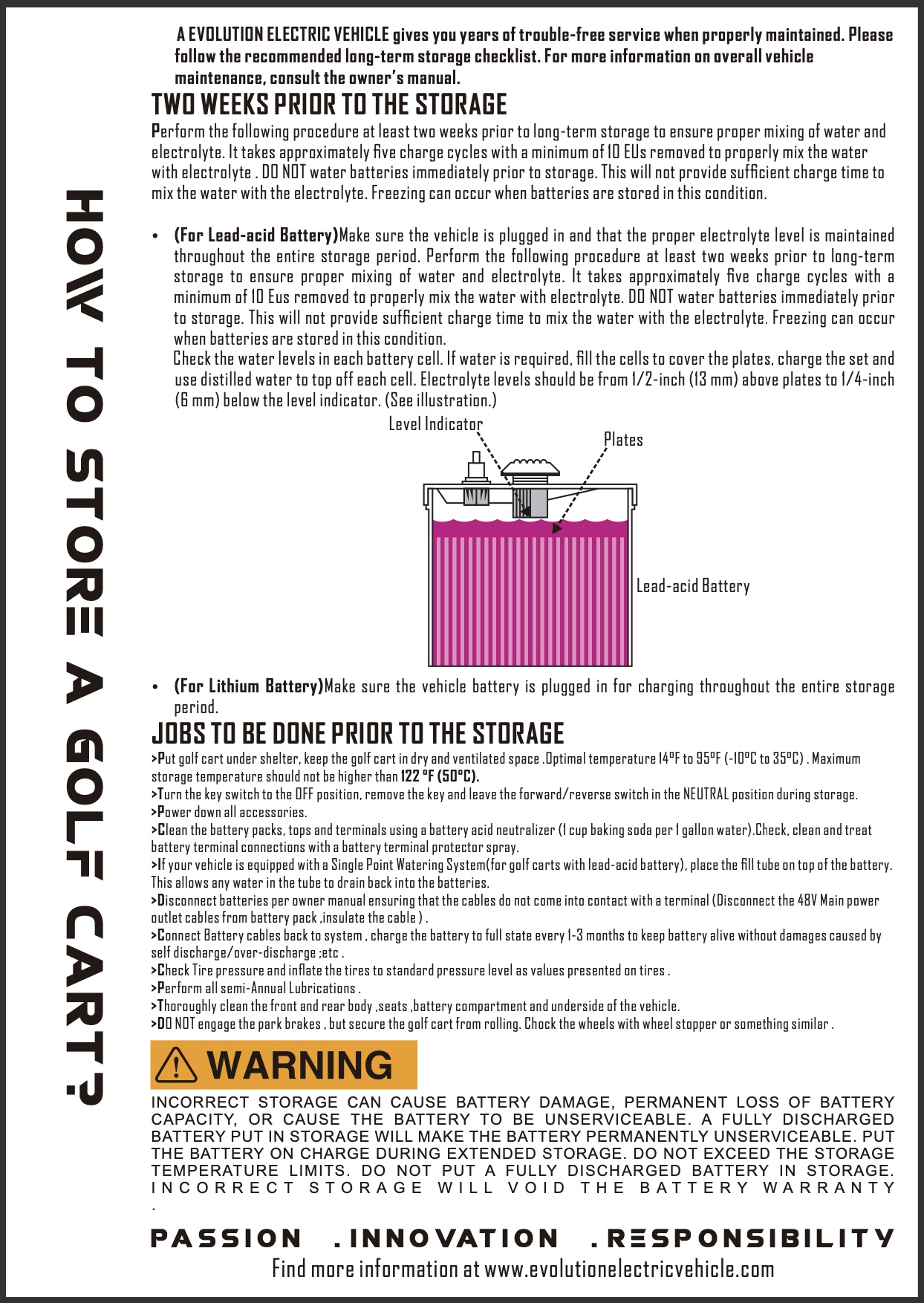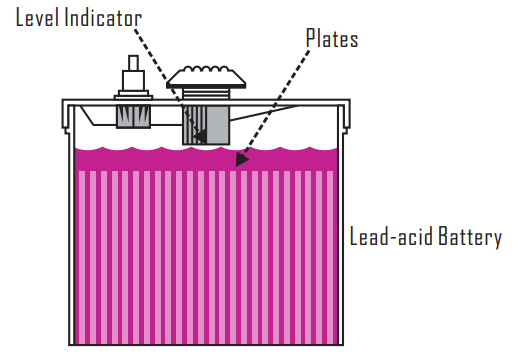

STORAGE
A EVOLUTION ELECTRIC VEHICLE gives you years of trouble-free service when properly maintained. Please follow the recommended long-term storage checklist. For more information on overall vehicle maintenance, consult the owner’s manual.
TWO WEEKS PRIOR TO THE STORAGEPerform the following procedure at least two weeks prior to long-term storage to ensure proper mixing of water and electrolyte. It takes approximately five charge cycles with a minimum of 10 EUs removed to properly mix the water with electrolyte . DO NOT water batteries immediately prior to storage. This will not provide sufficient charge time to mix the water with the electrolyte. Freezing can occur when batteries are stored in this condition.
. (For Lead-acid Battery)Make sure the vehicle is plugged in and that the proper electrolyte level is maintained throughout the entire storage period. Perform the following procedure at least two weeks prior to long-term storage to ensure proper mixing of water and electrolyte. It takes approximately five charge cycles with a minimum of 10 Eus removed to properly mix the water with electrolyte. DO NOT water batteries immediately prior to storage. This will not provide sufficient charge time to mix the water with the electrolyte. Freezing can occur when batteries are stored in this condition.
Check the water levels in each battery cell. If water is required, fill the cells to cover the plates, charge the set and use distilled water to top off each cell. Electrolyte levels should be from 1/2-inch (13 mm) above plates to 1/4-inch (6 mm) below the level indicator. (See illustration.)
. (For Lithium Battery)Make sure the vehicle battery is plugged in for charging throughout the entire storage period.
JOBS TO BE DONE PRIOR TO THE STORAGE>Put golf cart under shelter, keep the golf cart in dry and ventilated space .Optimal temperature 14°F to 95°F (-10°C to 35°C) . Maximum storage temperature should not be higher than 122 °F (50°C).>Turn the key switch to the OFF position, remove the key and leave the forward/reverse switch in the NEUTRAL position during storage.
>Power down all accessories.
>Clean the battery packs, tops and terminals using a battery acid neutralizer (1 cup baking soda per 1 gallon water).Check, clean and treat battery terminal connections with a battery terminal protector spray.
>If your vehicle is equipped with a Single Point Watering System(for golf carts with lead-acid battery), place the fill tube on top of the battery. This allows any water in the tube to drain back into the batteries.
>Disconnect batteries per owner manual ensuring that the cables do not come into contact with a terminal (Disconnect the 48V Main power outlet cables from battery pack ,insulate the cable ) .
>Connect Battery cables back to system , charge the battery to full state every 1-3 months to keep battery alive without damages caused by self discharge/over-discharge ;etc .
>Check Tire pressure and inflate the tires to standard pressure level as values presented on tires .
>Perform all semi-Annual Lubrications
>Thoroughly clean the front and rear body ,seats ,battery compartment and underside of the vehicle.
>DO NOT engage the park brakes , but secure the golf cart from rolling. Chock the wheels with wheel stopper or something similar .
Always:
. Maintain the vehicle in accordance with the manufacturer’s periodic service schedule.
. Ensure that repairs are performed by those that are trained and qualified to do so.
. Follow the manufacturer’s maintenance procedures for the vehicle. Be sure to disable the vehicle before performing any maintenance. Disabling includes removing the key from the key switch and removal of a battery wire.
. Insulate any tools used within the battery area in order to prevent sparks or battery explosion caused by shorting the battery terminals or associated wiring. Remove the batteries or cover exposed terminals with an insulating material.
. Check the polarity of each battery terminal and be sure to rewire the batteries correctly.
. Use specified replacement parts. Never use replacement parts of lesser quality.
. Use recommended tools.
. Determine that tools and procedures not specifically recommended by the manufacturer will not compromise the safety of personnel nor jeopardize the safe operation of the vehicle.
. Support the vehicle using wheel chocks and jack stands. Never get under a vehicle that is supported by a jack. Lift the vehicle in accordance with the manufacturers instructions.
. Maintain the vehicle in an area away from exposed flame or persons who are smoking.
. Be aware that a vehicle that is not performing as designed is a potential hazard and must not be operated.
. Test drive the vehicle after any repairs or maintenance. All tests must be conducted in a safe area that is free of both vehicular and pedestrian traffic.
. Replace damaged or missing warning, caution or information labels.
. Keep complete records of the maintenance history of the vehicle.
The manufacturer can not anticipate all situations, therefore people attempting to maintain or repair the vehicle must have the skill and experience to recognize and protect themselves from potential situations that could result in severe personal injury or death and damage to the vehicle. Use extreme caution and, if unsure as to the potential for injury, refer the repair or maintenance to a qualified mechanic.


